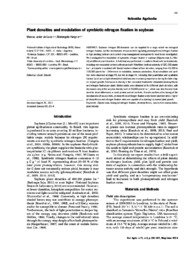Plant densities and modulation of symbiotic nitrogen fixation in soybean.
Plant densities and modulation of symbiotic nitrogen fixation in soybean.
Autoria: LUCA, M. J. de; HUNGRIA, M.
Resumo: Soybean nitrogen (N) demands can be supplied to a large extent via biological nitrogen fixation, but the mechanisms of source/sink regulating photosynthesis/nitrogen fixation in high yielding cultivars and current crop management arrangements need to be investigated. We investigated the modulation of symbiotic nitrogen fixation in soybean [Glycine max (L.) Merrill] at different plant densities. A field trial was performed in southern Brazil with six treatments, including non-inoculated controls without and with N-fertilizer, both at a density of 320,000 plants ha−1, and plants inoculated with Bradyrhizobium elkanii at four densities, ranging from 40,000 to 320,000 plants ha−1. Differences in nodulation, biomass production, N accumulation and partition were observed at stage R5, but not at stage V4, indicating that quantitative and qualitative factors (such as sunlight infrared/red ratio) assume increasing importance during the later stages of plant growth. Decreases in density in the inoculated treatments stimulated photosynthesis and nitrogen fixation per plant. Similar yields were obtained at the different plant densities, with decreases only at the very low density level of 40,000 plants ha−1, which was also the only treatment to show differences in seed protein and oil contents. Results confirm a fine tuning of the mechanisms of source/sink, photosynthesis/nitrogen fixation under lower plant densities. Higher photosynthesis and nitrogen fixation rates are capable of sustaining increased plant growth.
Ano de publicação: 2014
Tipo de publicação: Artigo de periódico
Unidade: Embrapa Soja
Palavras-chave: Fixação de nitrogênio, Nitrogen fixation, Soja, Soybeans
Observações
1 - Por padrão são exibidas publicações dos últimos 20 anos. Para encontrar publicações mais antigas, configure o filtro ano de publicação, colocando o ano a partir do qual você deseja encontrar publicações. O filtro está na coluna da esquerda na busca acima.
2 - Para ler algumas publicações da Embrapa (apenas as que estão em formato ePub), é necessário ter, no celular ou computador, um desses softwares gratuitos. Sistemas Android: Google Play Livros; IOS: iBooks; Windows e Linux: software Calibre.
Acesse outras publicações
Acesse a Base de Dados da Pesquisa Agropecuária (BDPA) para consultar o acervo completo das bibliotecas da Embrapa.

